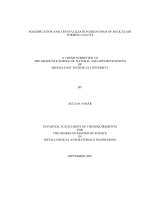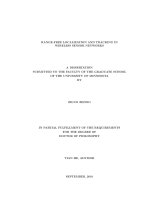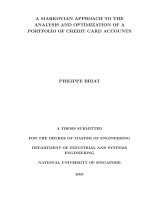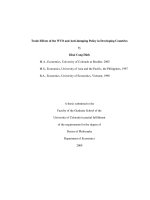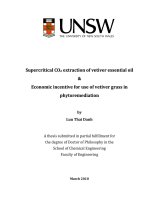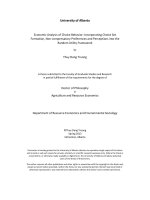a thesis submitted to the faculty of graduate studies and research in partial fulfillment of the requirements for the degree of doctor of philosophy in agriculture and resource economics
Bạn đang xem bản rút gọn của tài liệu. Xem và tải ngay bản đầy đủ của tài liệu tại đây (3.15 MB, 219 trang )
University of Alberta
Economic Analysis of Choice Behavior: Incorporating Choice Set
Formation, Non-compensatory Preferences and Perceptions into the
Random Utility Framework
by
Thuy Dang Truong
A thesis submitted to the Faculty of Graduate Studies and Research
in partial fulfillment of the requirements for the degree of
Doctor of Philosophy
in
Agriculture and Resource Economics
Department of Resource Economics and Environmental Sociology
©Thuy Dang Truong
Spring 2013
Edmonton, Alberta
Permission is hereby granted to the University of Alberta Libraries to reproduce single copies of this thesis
and to lend or sell such copies for private, scholarly or scientific research purposes only. Where the thesis is
converted to, or otherwise made available in digital form, the University of Alberta will advise potential
users of the thesis of these terms.
The author reserves all other publication and other rights in association with the copyright in the thesis and,
except as herein before provided, neither the thesis nor any substantial portion thereof may be printed or
otherwise reproduced in any material form whatsoever without the author's prior written permission.
ABSTRACT
The Random Utility Model has become the dominant empirical model used in
environmental valuation and other areas of consumer demand analysis involving the
choice of discrete items. This thesis investigates in detail three assumptions of the
Random Utility Model. It consists of three studies that either propose or evaluate
methods of relaxing the common assumptions. The first study examines models of
choice set formation – the determination of the set from which consumers make a
choice. It compares a fully endogenous choice set formation model, called the
Independent Availability Logit model (Swait, 1984), to the implicit availability function
approach (Cascetta and Papola, 2001) that approximates choice set formation. The
second study proposes an analytical model that incorporates non-compensatory
preferences in the framework of the Random Utility Model. The proposed model allows
for the estimation of “cutoffs” – the levels an attribute must satisfy or the alternative
will not be chosen or will be penalized – without prior information about these levels.
The third study explores structural models that allow for subjective perceptions of
attributes.
We find that models with choice set formation are better at capturing choice behavior
compared to standard random utility models. The choice set formation process also
affects welfare measures, indicating that ignoring choice set formation may result in
biased welfare estimates. The proposed method to estimate cutoff levels in the second
study appears to work well with synthetic data, however it is more challenging when
applied to real data. We find that it is important to include cutoff information in
empirical analysis, and that the results differ from models that use self-reported cutoffs.
In the third study, we find that subjective perception plays a significant role in the
decision making process.
The thesis also provides some policy relevant information. The first study provides
estimates of welfare measures for recreationists where wildlife is affected by Chronic
Wasting Disease. The second study provides estimates of the willingness to pay for
endangered species conservation. And the third study provides new estimates of the
values of risk aversion when subjective perceptions on probabilities of choice are
incorporated into the analysis.
ACKNOWLEDGEMENT
I am grateful to my supervisor, Dr. Vic Adamowicz, for his guidance, encouragement and
support, without which I could not complete my study program.
I would like to thank Dr. Peter Boxall for his valuable advice during my thesis writing
process. I also thank the members of my committee, Dr. Grant Hauer and Dr. Jeffrey
Scott for their valuable inputs. I also owe my thanks to Dr. Joffre Swait for his guidance
during the process of data analysis.
I would like to thank my wife, Diep, and my children Thien and Vy, for their
understanding and support, and ask for their forgiveness for my neglect. I also want to
thank Hyun No Kim and Min Jeon Shin for staying close to me and my family, sharing the
joyful moments and helping during the difficult times. I thank Edgar Twine for his help to
my family.
I also wish to express my thanks to the Social Sciences and Humanities Research Council
of Canada for funding my research, to the James Copeland Scholarship for offering me
its award in 2009 and 2011, to Dana Harper for her excellent job of collecting the
Caribou Conservation Survey data which I used for my thesis, to Natalie Zimmer for the
Deer Hunting Survey data, and to Dr. Glenn Harrison for allowing to use his risk aversion
experiment data. Special thanks to the staff and student-friends in the Department of
Resource Economics and Environmental Sociology for their help, and to the Government
of Viet Nam for its funding in the early years of my study program.
TABLE OF CONTENTS
1
CHAPTER 1: INTRODUCTION................................................................................1
1.1
Choice set formation ........................................................................................... 5
1.2
Non-compensatory preferences ......................................................................... 6
1.3
Subjective perception of attributes .................................................................... 8
REFERENCES .................................................................................................................. 10
2 CHAPTER 2: MODELLING THE EFFECT OF RISK PERCEPTION ON PREFERENCES AND
CHOICE SET FORMATION OVER TIME: RECREATIONAL HUNTING SITE CHOICE AND
CHRONIC WASTING DISEASE .................................................................................... 15
2.1
LITERATURE REVIEW ......................................................................................... 20
2.1.1
Choice set definition ................................................................................. 21
2.1.2
Explicit modeling of choice set generation ............................................... 23
2.1.3
Cascetta and Papola’s Implicit Availability and Perception model ........... 26
2.1.4
Applications............................................................................................... 28
2.2
DATA.................................................................................................................. 29
2.3
EMPIRICAL MODEL ............................................................................................ 31
2.4
RESULTS............................................................................................................. 36
2.4.1
MNL and CPA models ................................................................................ 37
2.4.2
IAL models ................................................................................................. 40
2.4.3
Welfare Measures ..................................................................................... 43
2.5
DISCUSSION AND CONCLUSIONS ...................................................................... 46
REFERENCES .................................................................................................................. 49
3 CHAPTER
3:
MODELLING
NON-COMPENSATORY
PREFERENCES
IN
ENVIRONMENTAL VALUATION ................................................................................. 56
3.1
LITERATURE REVIEW ......................................................................................... 60
3.1.1
Swait’s model ............................................................................................ 63
3.2
ENDOGENEOUS CUTOFF MODEL ...................................................................... 64
3.3
DATA.................................................................................................................. 70
3.4
SIMULATION WITH SYNTHETIC DATA ............................................................... 72
3.5
ESTIMATION WITH REAL DATA ......................................................................... 75
3.6
WELFARE MEASURES ........................................................................................ 81
3.7
CONCLUSIONS ................................................................................................... 84
REFERENCES .................................................................................................................. 87
4 CHAPTER 4: PROBABILITY WEIGHTING: THE EFFECT OF INCENTIVE, MOODS AND
HETEROGENEITY ...................................................................................................... 90
4.1
EUT AND RA MEASUREMENT METHODS .......................................................... 93
4.2
NON-EUT WITH DECISION WEIGHTS................................................................. 96
4.3
MODEL SPECIFICATION ................................................................................... 100
4.4
DATA................................................................................................................ 104
4.5
RESULTS........................................................................................................... 106
4.6
DISCUSSION ..................................................................................................... 113
REFERENCES ................................................................................................................ 116
5
CHAPTER 5: CONCLUSIONS.............................................................................. 122
REFERENCES ................................................................................................................ 129
6
APPENDICES ................................................................................................... 131
6.1
APPENDIX 1: CWD SURVEY 2009 .................................................................... 131
6.2
APPENDIX 2: CARIBOU CONSERVATION SURVEY IN ALBERTA ........................ 148
6.2.1
PART 1: WORKSHOP POWERPOINT PRESENTATION .............................. 148
6.2.2
PART 2: WOODLAND CARIBOU CONSERVATION VALUATION PACKAGE 168
6.3
APPENDIX 3: ADDITIONAL ENDOGENEOUS CUTOFF MODELS........................ 200
6.3.1
cutoff
Appendix 3.1: Estimation results of endogenous cutoff model with herd
200
6.3.2
Appendix 3.2: Estimation results of endogenous cutoff model with 4category herd cutoff ............................................................................................... 201
6.4
APPENDIX 4: EXPERIMENT SCRIPT AND QUESTIONNAIRE OF HARRISION ET AL.
(2005) 202
6.5
APPENDIX 5: STATISTICS OF HARRISON ET AL. (2005) DATA .......................... 210
LIST OF TABLES
Table 2.1: Data structure – number of choices................................................................. 31
Table 2.2: Attributes and levels ........................................................................................ 33
Table 2.3: Estimation Results: MNL, CPA and IAL Models of Site Choice ......................... 39
Table 2.4: Implied Probabilities of Choice Set Size from the IAL Model ........................... 41
Table 2.5: Welfare Changes of Moving to the “Worst Case” Scenario ............................. 46
Table 3.1: True parameters and estimation results .......................................................... 74
Table 3.3: Statistics ........................................................................................................... 75
Table 3.4: MNL models ..................................................................................................... 77
Table 3.5: Estimation results of endogenous cutoff model .............................................. 79
Table 3.6: Comparison of self-reported and predicted cutoffs ........................................ 81
Table 3.7: Willingness To Pay for woodland caribou management strategies ................. 83
Table 4.1: Holt and Laury’s risk aversion experiment – 1X scale .................................... 104
Table 4.2: Estimation results of EU and RDU models ..................................................... 108
Table 4.3: Risk aversion estimate for a representative subject(*) from different models
........................................................................................................................................ 113
LIST OF FIGURES
Figure 2.1: Probability of choosing WMU 148 as CWD prevalence changes .................... 42
Figure 4.1: Probability weighting functions .................................................................... 110
Figure 4.2: Probability weighting function of a U.S. citizen, 21 year old female subject at
1X scale games at different standard deviations ............................................................ 112
1
CHAPTER 1: INTRODUCTION
The theory of individual choice, which attempts to explain the economic behavior of
choice among discrete alternatives, has been applied to a variety of issues. The theory
was first applied to transportation demand, particularly the choice among
transportation modes (Swait, 1984). It was then found to provide a tractable model for
analyzing choice behavior in other fields. In environmental valuation, it has been applied
to choice data generated in markets (actual choices or Revealed Preference data), and
data arising from hypothetical markets or choices (Stated Preference data) (Bockstael
and McConnell, 2007). The theory has also been applied to experimental economic data
on respondents’ choices among options, which is one of the methods used to analyze
choice under risk and uncertainty (Harrison and Rutström, 2008). Other fields of
application of individual choice theory include choice of technology adoption, choice of
crops, fuel, participation in conservation programs and health risk reductions (Bockstael
and McConnell, 2007).
The theory of individual choice was developed based on principles of psychology,
particularly the Law of Comparative Judgment of Thurstone (1927). In this theory,
individuals react to stimuli. When choosing among alternatives, individuals tend to
choose the alternative with the highest perceived level of stimulus, which comprises its
objective level and a random error. This stimulus is interpreted by economists as the
level of satisfaction or utility, which is equal to a systematic plus a random component
1
(Marschak, 1960, Manski, 1977). The choice decision then complies with standard
economic theory: individuals choose the alternative with the highest level of utility. This
is the basic idea of the Random Utility Model (RUM).
Today the RUM is the dominant paradigm used in understanding how people make
choices. The specification of a random and a systematic component of utility allows for
the econometric analysis of choices to estimate parameters of preference for
multidimensional goods. Because the random component of utility is unknown to
analysts, the model becomes probabilistic. Instead of identifying the chosen option, it
predicts the probability of each alternative being chosen. The RUM was made popular
by McFadden (1978) through several models including the multinomial logit model
(MNL – which assumes a Gumbel distribution error), the nested logit model and the
generalized extreme value (GEV) model. In these models, utility is specified as a function
of attributes of the alternatives under consideration.
The simplest RUM is based on several assumptions, including Independence of
Irrelevant Alternatives (IIA), an additive error, homogeneous preferences and a
homogeneous scale. The assumptions of IIA introduced by Luce (1959) states that the
ratio of choice probabilities of two alternatives must be the same for every choice set
that includes them. In other words, the ratio must be unchanged when one or more
alternatives are included or excluded from the choice set. Choice models may produce
biased estimates if IIA fails. The assumption of an additive error requires that the error
term is additive to the systematic component of utility. In addition, a specific
distribution of the error term has to be assumed. Homogenous preferences imply that
2
individuals have identical utility functions. Homogenous scale means that the variance
of the random error is identical for all individuals.
In addition to these assumptions, a typical application of RUM usually employs several
additional assumptions. First, the choice set, or the set of alternatives that individual
decision makers choose from, must be known and fixed. In the case of stated preference
methods, researchers present a designed set of alternatives to respondents and ask for
a choice (Grafton et al., 2003). In some cases of revealed preference methods, for
example recreational site choice, researchers define the alternatives of a site using rules
such as distance (Parsons and Hauber, 1998). Second, it is usually assumed that utility is
a linear function of alternatives’ attributes, implying a compensatory preference
structure. The assumption of compensatory preferences implies that a change in one
attribute can be compensated for by a change in another attribute. Finally, it is usually
assumed that there is no difference between the attribute levels perceived by the
individual and those used by the researchers. In other words, individuals are assumed to
be using the same attribute levels that the researcher is using in making their decisions,
whether these are objective measures of attributes collected by the researcher or
attributes as presented to the respondent by the researcher in an experiment or stated
preference task. This assumption rules out the possibility that perceptions differ from
objective measures.
The basic structure of the RUM has been expanded in many ways relaxing some of the
restrictive assumptions of the model. The assumption of stochastic independence was
relaxed by the GEV model (McFadden, 1978, Ben-Akiva and Francois, 1983). The
3
assumption of homogeneity of preferences was relaxed by models such as the random
parameter logit model (Ben-Akiva and Bolduc, 1996, Bolduc et al., 1996, Ben-Akiva and
Bierlaire, 1999, Train 2003). The assumption of homogeneity in variance/scale was
relaxed by models that include the scale function (Swait and Louviere, 1993). However,
other assumptions within the RUM framework have not been fully explored.
This thesis examines three of the above assumptions in detail. It proposes ways to relax
the assumptions, or evaluates methods of relaxing the assumptions of RUM, and
provides empirical information for policy analysis. It consists of three studies that are
expected to provide a better understanding of choice behavior by developing and/or
employing extensions of the RUM framework. The first assumption to be examined is
that decision makers make choices from a full, known set of alternatives. This thesis
evaluates different methods of relaxing this assumption. Second, the thesis proposes a
new technique to relax the compensatory preference assumption. Finally, the thesis
explores structural models that allow for personal perceptions of attribute levels. This
thesis has three objectives. The first is to evaluate models of choice set formation and
the effect they have on preference measures and welfare estimates. This will be done in
the context of recreation demand over time. The second is to model non-compensatory
preference in the framework of RUM and estimate cutoff levels as a function of
individual characteristics. The third is to separate subjective perceptions and objective
levels of attributes and investigate factors that affect subjective perceptions using a
structural mode.
4
1.1 Choice set formation
When facing a set of alternatives, decision makers may narrow their choice sets using
some specific criteria, and make the choice within the alternatives remaining in their
individual choice sets. Some alternatives may be excluded from the individual choice set
if their attributes do not meet certain thresholds or levels. The process of narrowing the
choice set is called choice set formation. Ignoring choice set formation processes can
result in biased estimates of the utility function parameters (Swait and Ben-Akiva, 1987).
The first study of this thesis investigates alternative models of choice set formation by
analyzing the responses of Albertan hunters to chronic wasting disease (CWD – a prion
disease that affects deer and elk and was found in Alberta in 2005 (Government of
Alberta, 2010)). Typical analysis of recreation choice data ignores the choice set
formation process – potentially resulting in incorrect predictions and policy prescriptions
(Peters et al., 1995; Parsons and Hauber, 1998). Few researchers have modeled the
choice set formation process endogenously – as an integral component of the choice
process. The CWD context provides an application in which hunters may remove
alternatives from their choice set when they know that the site is affected by the
disease. Thus this case is an excellent situation to conduct analysis of choice set
formation as a methodological assessment and as a contribution to the policy process of
the management of CWD. This study examines whether and how attributes, specifically
CWD, can affect evaluation and choice set formation over time using different choice set
formation models.
5
This study evaluates the two methods of modeling choice set formation, particularly the
Independent Availability Logit model (Swait, 1984), which is the fully endogenous choice
set formation model, and the availability function approach (Cascetta and Papola, 2001)
that approximates choice set formation. The study separates the responses to CWD risk
and new information on CWD into the effect on the choice set and the effect on
preferences. By using data from hunters’ site choices over a two year period, the study
provides a richer understanding of choice behavior, including choice set formation, over
time. The scale function, which relaxes the assumption of homogeneous variance, is also
incorporated. The study also makes an empirical contribution by providing measures of
the welfare impact of CWD over groups of hunters and over time.
1.2 Non-compensatory preferences
The fact that some alternatives may not be considered if their attributes do not satisfy
some requirements can be viewed as a choice set formation process, but it can also be
viewed as a form of non-compensatory preference. In the case of non-compensatory
preferences a change in one attribute may not be compensated for by a change in
another attribute. As a result, alternatives that do not satisfy certain requirements of
the decision makers will never be chosen, even if they are in the choice set. Choosing
the utility maximizing alternative from the set of alternatives in choice set formation
model is essentially the same as choosing the optimal one that satisfies the
requirements in non-compensatory models (Swait, 2001).
Typical applications of the RUM assume a linear utility function. This implies perfect
compensation or “tradeoffs” between attributes, which has been criticized as it may not
6
adequately capture preferences. A non-compensatory framework may be better, but it
requires that a certain level of an attribute must be satisfied in order for an alternative
to be considered – this level is referred to as a “cutoff”. Alternatives that violate cutoffs
may be penalized in terms of utility, or eliminated from the choice set if the penalty is
large enough.
Gensch and Svetska (1984), Elrod et al. (2004) and Martinez et al. (2009) proposed
various methods to estimate cutoffs. However, these methods estimate aggregate
cutoffs and thus do not allow for different cutoffs points for different individuals. In
other research that involves cutoffs, the cutoffs are usually elicited directly from the
respondents, and are assumed to be exogenous. However this information is not always
available and the elicitation may introduce other econometric difficulties in the model.
Self-reported cutoffs have been shown to be unreliable because decision makers may be
willing to change or violate their cutoffs when evaluating a particular alternative (Swait,
2001, Huber and Klein, 1991, Klein and Bither, 1987). Therefore, there is a need for a
model that can test for the existence of cutoffs as well as estimate the cutoff levels
without prior information about the cutoffs.
The second study develops a new method that modifies the standard MNL model to
estimate cutoff levels and correlate cutoffs with individual characteristics. The model is
tested with synthetic data. The model is then applied to choices by Albertans of
different policy strategies for conserving woodland caribou, which is listed as a
“Threatened” species (COSEWIC, 2002, ASRD and ACA, 2010). By estimating cutoffs in
this case the study can identify the preferences for, and economic value of, conservation
7
programs, and assess the extent to which there are thresholds or cutoffs in these
preferences. Estimated cutoffs are also compared to elicited cutoffs. This paper also
makes an empirical contribution by providing estimates of the willingness to pay for
threatened species conservation and information on thresholds or cutoffs over the
population sampled.
1.3 Subjective perception of attributes
When considering alternatives that involve risk attributes, decision makers may
eliminate alternatives that may be considered “too risky”, which is the case for choice
set formation processes. However, the decision makers may not think about the risk
data in the same way as they are presented by researchers. When presenting decision
makers with the choice set, researchers usually present the set of attributes of each
alternative and assume that the decision makers will make choices based on the
information provided (objective values). This ignores the possibility of subjective
perception of attributes. As a result, using objective values to analyze the choice
behavior may be misleading.
The issue of subjective perception of attributes has been discussed in the environmental
valuation literature. Adamowicz et al. (1997) found that the model estimated using
perceived values of attributes (obtained directly from respondents) outperforms the
model that uses objective attribute values. The issue may be even more important in
the elicitation of risk preferences given that individuals often have difficulties processing
risks and probabilities of outcomes.
8
The third study examines perceptions versus objective measures of risk. Analysis of risk
aversion usually employs an expected utility model, which does not account for the
possibility that subjects may perceive probabilities or hold subjective beliefs about
probabilities. Ignoring the fact that subjects may subjectively weight probabilities may
result in biased estimates of the risk aversion coefficient of the utility function.
This study analyzes data from Harrison et al. (2005). Each alternative in this study
involves different outcomes with different objectively described probabilities. A
structural model is developed which effectively allows subjects to apply weights to
objective probabilities in order to form subjectively weighted probabilities, and make
choices based on these weighted probabilities. A RUM with a scale function, nonlinear
utility and weighting function together with random parameters is applied to analyze
the choice under uncertainty. This study employs a structural model to separate
subjective perceptions and objective levels of attributes in choice, and to investigate
factors that affect subjective perceptions.
In summary, this thesis examines three areas of individual choice behavior. Each study
either evaluates or proposes methods to relax assumptions about choice behavior or
preferences. The first study finds that choice set formation affects welfare measures,
and this effect may change over time or by the provision of information. This highlights
the importance of including choice set formation processes in analyses that involve risk
and wildlife, and probably other cases as well. The study also finds that the
approximation of choice set formation (Cascetta and Papola, 2001) may not adequately
reflect choice set formation and capture such effects. The model that captures non-
9
compensatory preferences developed in the second study is found to be able to recover
the true parameters when applied to synthetic data. This model shows that such cutoff
information is important to include in empirical analysis and that the results differ from
models that use self-reported cutoffs. In the third study, it is found that perceptions of
attributes may play a significant role in the process of choice decision, and particularly
for the research problem examined in this study, it may considerably affect the
measurement of risk aversion.
The next three chapters present the three studies. Chapter 2 examines the choice set
formation models using the responses of Albertan hunters to chronic wasting disease.
Chapter 3 proposes a model that estimates cutoffs endogenously and then applies the
model to data from a survey in Alberta about woodland caribou conservation. Chapter 4
explores structural models that allow for subjective perception of attributes to the
analysis of choice under uncertainty. Chapter 5 provides some general conclusions.
REFERENCES
Adamowicz, W., J. Swait, P. Boxall, J. Louviere and M. Williams. 1997. Perceptions Versus
Objective Measures of Environmental Quality in Combined Revealed and Stated
Preference Models of Environmental Valuation. Journal of Environmental Economics
and Management 32: 65–84.
Alberta Sustainable Resource Development and Alberta Conservation Association. 2010.
Status of the Woodland Caribou (Rangifer tarandus caribou) in Alberta: Update 2010.
Alberta Sustainable Resource Development. Wildlife Status Report No. 30 (Update
2010). Edmonton, Alberta.
10
Ben-Akiva, M. and B. Francois. 1983. -Homogeneous generalized extreme value
model. Working paper, Department of Civil Engineering, MIT, Cambridge.
Ben-Akiva, M. and D. Bolduc. 1996. Multinomial probit with a logit kernel and a general
parametric specification of the covariance structure. Paper presented at the 3rd
Invitational Choice Symposium, Columbia University.
Ben-Akiva, M. and M. Bierlaire. 1999. Discrete choice methods and their applications to
short-term travel decisions, in R. Hall (ed.), Handbook of Transportation Science,
Kluwer, pp. 5-34.
Bockstael, N.E. and K.E. McConnell. 2007. Environmental and Resource Valuation with
Revealed Preferences. Dordrecht, The Netherlands: Springer.
Bolduc, D., B. Fortin and M. Fournier. (1996). The effect of incentive policies on the
practice location of doctors: A multinomial probit analysis, Journal of Labor
Economics 14 (4): 703-732.
Cascetta, E., A. Papola, 2001. Random utility models with implicit availability/perception
of choice alternatives for the simulation of travel demand. Transportation Research
Part C 9 (4): 249–263.
COSEWIC. 2002. COSEWIC assessment and update status report on the woodland
caribou Rangifer tarandus caribou in Canada. Committee on the Status of
Endangered Wildlife in Canada. Ottawa.
11
Elrod, T., R.D. Johnson and J. White. 2004. A new integrated model of noncompensatory
and compensatory decision strategies. Organizational Behavior and Human Decision
Processes 95: 1-19.
Gensch, D.H. and J.A. Svetska. 1984. A Maximum Likelihood Hierarchical Disaggregate
Model for Predicting Choices of Individuals. Journal of Mathematical Psychology 28:
160-178.
Government of Alberta. 2010. Sustainable Resources Development website. Chronic
Wasting
Disease.
/>gDisease/Default.aspx Accessed 8 February 2011.
Grafton, Q., W.L. Adamowicz, D. Dupont, H. Nelson, R. Hill and S. Renzetti. 2003. The
Economics of the Environment and Natural Resources. Blackwell.
Harrison, G. and E.E. Rutström. 2008. Risk Aversion in the Laboratory. Research in
Experimental Economics 12: 41-196.
Huber, J. and N. M. Klein. 1991. Adapting Cutoffs to the Choice Environment: The Effects
of Attribute Correlation and Reliability. Journal of Consumer Research 18(3): 346357.
Klein, N. M. and S. W. Bither. 1987. An Investigation of Utility-Directed Cutoff Selection.
Journal of Consumer Research 14(2): 240-256.
Luce, R. D. 1959. Individual Choice Behavior: A Theoretical Analysis. New York: Wiley.
12
McFadden, D. 1978. Modeling the choice of residential location. Transportation
Research Record 672: 72-77.
Manski, C.F. 1977. The Structure of Random Utility Models. Theory and Decision 8: 229254.
Marschak, J. 1960. Binary-choice constraints and random utility indicators. In
Mathematical Methods in the Social Sciences, edited by K. J. Arrow, S. Karlin, and P.
Suppes. Stanford, California: Stanford University Press.
Martinez, F., F. Aguila and R. Hurtubia. 2009. The constrained multinomial logit: A semicompensatory choice model. Transportation Research Part B 43: 365-377.
Peters, T., W. Adamowicz and P. Boxall. 1995. The Influence of choice set consideration
in modelling the benefits of improved water quality. Water Resources Research 613:
1781-7.
Parsons, G. and A. Hauber. 1998. Spatial boundaries and Choice Set Definition in a
Random utility model of Recreation Demand. Land Economics 74(1): 32-48.
Swait, J. 1984. Probabilistic choice set formation in transportation demand models.
Unpublished Ph.D. Thesis. Department of Civil Engineering, MIT, Cambridge, MA.
Swait, J. 2001. A non-compensatory choice model incorporating attribute cutoffs.
Transportation Research Part B 35: 903-928.
Swait, J. and J.J. Louviere. 1993. Role of the scale parameter in the estimation and
comparison of multinomial logit models. Journal of Marketing Research 30(3): 305314.
13
Swait, J. and M. Ben-Akiva. 1987. Incorporating random constraints in discrete choice
models of choice set generation. Transportation Research B 21(2): 91-102.
Thurstone, L.L. 1927. A Law of Comparative Judgment. Psychological Review 4:273-286.
Train, K. 2003. Discrete Choice Methods with Simulation. New York: Cambridge
University Press.
14
2
CHAPTER 2: MODELLING THE EFFECT OF RISK PERCEPTION ON
PREFERENCES AND CHOICE SET FORMATION OVER TIME:
RECREATIONAL HUNTING SITE CHOICE
AND CHRONIC WASTING DISEASE
The economics of recreation demand was initially analyzed using the travel cost model
(Hotelling 1949 and Clawson 1959), in which the demand for trips to a specific site
decreases with price (travel cost). The application of random utility models (RUM) to
recreation site choice allows for the analysis of the effect of attributes other than price
on recreation demand (including potential health risks at sites), and to more fully
examine substitution patterns between options. The site choice model was proposed by
Hanemann (1978), in which every trip is considered a choice where an individual is
assumed to choose the site that maximizes his utility, given the constraint of income and
time.
The application of RUMs to recreation site choice allows the analysis of the response to
health risks by considering this risk as a site attribute. Some researchers have examined
the response of recreation demand to risk perceptions. Diana et al. (1993) and May and
Burger (1996) examined anglers’ compliance with health advisories and found most
anglers ignored consumption advisories. Jakus et al. (1997), however, found anglers
were less likely to visit a reservoir with an advisory. Jakus and Shaw (2003) proposed a
two-level nested multinomial logit (MNL) model to analyze the behavior of keeping fish
from sites simultaneously with site choice behavior. The probability of not keeping fish
15
from a site is considered a proxy of hazard perception and this was found to drive
anglers away from a site. Zimmer et al. (2012) analyzed the effect of Chronic Wasting
Disease (CWD), a degenerative wasting disease that affects deer, moose and elk, on
hunting site choice in Alberta using a nested MNL model and found that the prevalence
of the disease as well as wildlife management disease mitigation efforts affect site
choice.
One of the key components of the RUM approach is the definition of the choice set, the
set from which the consumer chooses a preferred option. The choice set is often defined
exogenously by the researcher, based on rules or data availability. Increasingly,
however, it is being recognized that choice set formation, or endogenous choice set
determination, is an important component of consumer behavior (Swait 1984, 2001a).
This applies in the recreation demand case that we study, as well as in cases of
transportation mode choice, food product choice, housing choice, and other areas
where random utility models are employed.
To the best of our knowledge, none of the previous research examining health risks and
recreation choice analyze response to risk in a two-stage decision process to account for
the process of choice set formation. If there are a large number of possible sites,
decision makers may narrow their choice sets using some specific criteria, and then
make a choice within those sites in their individual choice sets. Mis-specification of
individual choice sets, for example including alternatives that are not actually
considered by the respondents or not including those considered, might result in biased
estimates of the utility function and welfare measures (see, for example, Hicks and
16
Strand, 2000). Failing to include relevant alternatives or including irrelevant alternatives
may introduce bias to the estimated parameters and welfare measures. This is because
the modeled probability of choosing an alternative j depends on the choice set, and
thus the log-likelihood function also depends on the choice set.
Several attempts have been made to deal with the issue of choice set formation in the
RUM. Peters, Adamowicz and Boxall (1995) asked respondents to specify the
alternatives to be considered before making final decisions. Choice set formation has
also been modeled endogenously. Haab and Hicks (1997) Swait (1984), Swait and BenAkiva (1986, 1987a,b), Roberts and Lattin (1991), Andrews and Srinivasan (1995), BenAkiva and Boccara (1995), Chiang et al. (1999) and von Haefen (2008) have explicitly
modeled choice set formation based on the two-stage choice process as formulated by
Manski (1977). Swait (2001a) developed a model that does not consider choice set
generation as a separate construct, but another expression of utility.
The explicit modeling of choice set formation is challenging when there are large choice
sets, and models approximating the choice set formation process have been developed.
Cascetta and Papola (2001) introduced the implicit availability perception function as an
extension of the standard MNL model to allow decision makers to have an individual
degree to which an alternative is considered for final decision (see also Kuriyama et al.
2003). The model is extended by Martinez et al. (2009). While this approach is an
approximation, it does provide a tractable method for incorporating choice set
formation into RUM models that have many alternatives.
17

